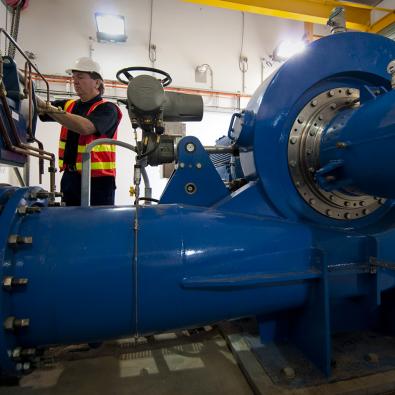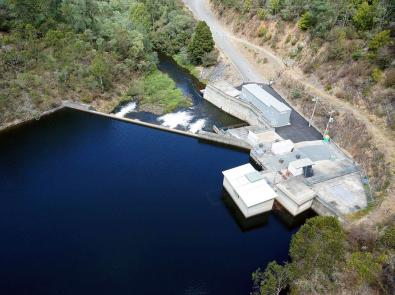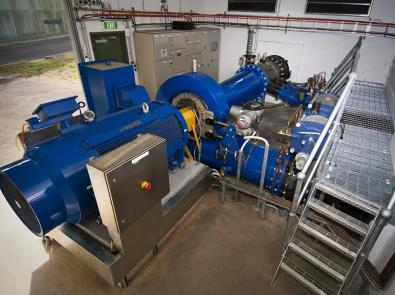Our hydroelectric power stations harness a natural, sustainable and reliable source of energy to generate renewable electricity – and reduce our carbon footprint. Learn how it works and the benefits to Melbourne.
How hydropower works
Hydropower is energy captured from the pressure of falling or fast-moving water.
- On its way to Melbourne, water is transferred via gravity from our major storage reservoirs (located at high elevations) to our smaller service reservoirs (at lower elevations).
- Water pressure in the pipelines must be managed as they approach the lower reservoirs. In the past this was achieved using pressure-reducing valves, but rather than letting this energy go to waste, we now channel the water through hydroelectric turbines.
- Pressure on the turbine blades rotates a shaft, which drives an electrical generator that converts the motion into electricity.
- The electricity is fed back into the power grid, reducing our operating costs – and costs to customers.
Watch this video for an overview of the process:
Our hydroelectric program
We generate electricity throughout our water supply network, with our suite of 14 hydroelectric power stations now producing more energy than we use.
Thanks to our mini-hydroelectricity plants:
- 69,500 megawatt hours of power are generated each year – equal to…
- 14,100 homes powered
- 75,800 tonnes of carbon dioxide emissions are prevented, about the same as…
- 29,200 cars taken off the road
We’re continuing to expand our network of mini-hydros. Our new power station at St Albans is in its proof of performance stage and will be completed in mid 2023. Upper Yarra Reservoir will be completed in late 2023, and O’Shannassy in late 2024.
This is part of our commitment to tackling climate change and helping to decarbonise the Victorian electricity grid.
Power stations
See where our stations are located within Melbourne’s water supply network:
| Station location | Capacity (megawatts) | Date commissioned | Status |
|---|---|---|---|
| Thomson | 7.4 | 1989 (upgraded in 2012) | Operating |
| Sugarloaf | 4.0 | 2010 | Not in operation |
| Cardinia | 3.5 | 1984 | Operating |
| Preston | 2.0 | 2008 | Operating |
| Silvan | 1.8 | 2008 | Operating |
| Olinda | 1.0 | 2009 | Operating |
| Upper Yarra | 0.90 | 2009 | Operating |
| Mt View | 0.56 | 2009 | Operating |
| Notting Hill | 0.40 | 2009 | Operating |
| Dandenong | 0.36 | 2017 | Operating |
| Mt Waverley | 0.33 | 2017 | Operating |
| Wantirna | 0.13 | 2017 | Operating |
| Boronia | 0.11 | 2017 | Operating |
| Cardinia Creek | 0.09 | 2017 | Operating |
History of our hydropower
1984-89
Our first hydroelectric power station was installed at Cardinia Reservoir in 1984.
This was followed by Thomson Reservoir in 1989, which was later upgraded in 2012.
2004
We reviewed our water supply network and identified sites that had potential for hydroelectric generation. These were assessed and ranked on their:
- ability to generate electricity
- availability of the local electricity network to accept power generated
- economic viability
- risk associated with their operation.
A key operational challenge was sudden turbine shutdowns and their potential to generate pressure transients, or “water hammers”, in the supplying water pipeline. This risk was eliminated through innovative power station design, valving and surge mitigation devices.
2008-10
Six mini hydroelectric power stations were built throughout the water supply network.
In 2010, an energy recovery hydroelectric power station was installed on the outlet of the North-South Pipeline.
2016-17
Five new hydroelectric power stations were added to the water supply network.
Their design drew heavily on learnings gained during past construction, and significant advances were made in housing the units and minimising their cost of construction.
Watch the following video to see how this was achieved:
2020-22
Three new mini-hydro power stations will be built and commissioned at St Albans, O’Shannassy and Upper Yarra Reservoirs.






